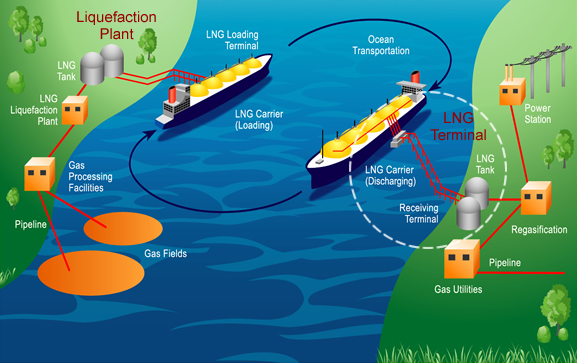
Liquefied Natural Gas (LNG): Exploration & Production Process – Manjur Khan (19N)
Introduction
Safe and efficient handling, stowage and transportation of goods by sea, amongst others, are some of the key tasks best performed by mariners. As deserved, goods in custody are treated with utmost respect for safe delivery. Any cargo carried by sea is perceived to be a product ready at its transportable status. It is not usually expected of a mariner to know where and how the cargo was produced other than its characteristics and associated hazards for safe transportation by sea.
Shipping and transporting LNG by sea is a day-to-day task for many mariners at sea. These skilled mariners are thoroughly familiar with the characteristics and safe transportation of LNG by sea. Oil & gas sector is a vast and complex industry. Many mariners at various stages of their career have supported different sectors of this industry. Not everyone had the opportunity to know or see all stages of the complex exploration and production cycles of hydrocarbons carried by sea.
This article aims to explain, in layman terms, LNG basic knowledge and exploration & production process. Throughout the article, references have been drawn from a wide range of resources and author’s personal industry experience. It is intended to use the article as a vehicle to share oil & gas industry knowledge with a wide range of audience including aspiring mariners.
Liquefied Natural Gas (LNG)
Liquefied Natural Gas (LNG) is natural gas, predominantly methane (90%) with some mixture of ethane, propane, butane, some heavier alkaline and nitrogen that has been condensed into a cryogenic liquid through liquefaction process at close to atmospheric pressure by cooling it to approximately −162°C or less for ease of storage or transportation. The liquefaction process involves removal of certain components, such as dust, acid gases, helium, water and heavy hydrocarbons.
It takes up about 1/600th the volume of natural gas in the gaseous state. Maximum transport pressure is set at around 25kPa. Approximate lower and upper flammable limit is between 5% and 15% by volume in the air. It is odourless, colourless, non-toxic and non-corrosive. Hazards include flammability after vaporization into a gaseous state, freezing and asphyxia.
Natural gas was formed over hundreds of millions of years from organic matter, such as plankton, plants and other life forms, which is why it is sometimes referred to as ‘Fossil Fuel’. Over time, sand, sediment and rock buried the organic matter and eventually large quantities of natural gas were formed and trapped under ground. Natural gas can be “associated” (found in oil fields), or “non-associated” (found in natural gas fields), and is also found in coal beds (as coal seam gas).
The world has enormous quantities of natural gas, but much of it is in areas far from where the gas is needed. The dramatic reduction in volume allows it to be shipped safely and efficiently aboard specially designed LNG vessels. After arriving at its destination, LNG is warmed to return it to its gaseous state, ‘mercaptan’ is added for odour and delivered to consumers through local pipelines as a source of clean energy (Learn more¹).
LNG Value Chain
East Asia, which includes Japan, is the largest natural gas consumer in the world. Many of the world’s largest gas fields are found in the Middle East, Southeast Asia, and Australia. East Asia is located some distance away and separated by oceans from these areas. For transportation to East Asia, natural gas is liquefied to reduce it to one six-hundredth of its original volume, and then transported on LNG carriers. As a result, an “LNG Chain” is required, by which natural gas that has been extracted from a gas field is refined, liquefied, transported by ships, and then re-gasified in the area where it is to be consumed.
LNG Commercial Aspects
In the commercial development of an LNG value chain, LNG suppliers first confirm sales to the downstream buyers and then sign long-term contracts (typically >20 years) with strict terms and structures for gas pricing. Only when the customers are confirmed and the development of a Greenfield Project deemed economically feasible, the sponsors of an LNG project invest in their development and operation. Hence, the LNG liquefaction business has been limited to players with strong financial and political resources. Major international oil companies (IOCs) such as ExxonMobil, Royal Dutch Shell, BP, BG Group, Chevron and some national oil companies (NOCs) are active players in the world LNG market.
LNG quality is one of the most important issues in the LNG business. LNG is sold based on its heating or calorific value which depends on the source of gas that is used and the process that is used to liquefy the gas. The range of heating value can span +/- 10 to 15 percent. The typical higher and lower heating value of LNG is approximately 50 MJ/kg or 21,500 BTU/lb and 45 MJ/kg or 19,350 BTU/lb.
Exploration and Production Process
Oil and gas developments are evolving from conventional to unconventional resources for onshore, and from shallow to deep water for offshore. Offshore developments are shifting from shallow water areas such as Middle East, the North Sea, South East Asia, North America and Australia to deep waters in Africa, Brazil, the Gulf of Mexico and the Artic.
Oil major companies use highly advanced multi-dimension seismic acquisition and processing technologies such as ocean bottom nodes and full waveform inversion modeling as well as interpretive and interactive seismic modeling and imaging algorithms. These technologies improve their understanding of complex subsurface conditions throughout the life of their assets from exploration stage to ongoing reservoir management. LNG production process is in two (2) distinct divisions and as follows:
1. Offshore – Upstream Production Process
Offshore developments require a long period of time (5 to 15 years) from exploration to the start of production. A typical development process consists of four (4) stages:
“Exploration” is the 1st stage that involves the discovery of oil or gas prospects through geophysical and geological study and exploration.
“Development” is the 2nd stage that assesses the recoverable reserves by drilling some appraisal wells and analysing the data obtained from the appraisal well. At this time, the operator will determine a development plan detailing key development milestones.
Through conducting sequential feasibility and concept studies, and ‘Front-End Engineering and Design’ (FEED) to produce quality process and engineering documentation of sufficient depth, defining the project requirements for engineering, procurement, fabrication and construction of facilities and supporting a ±10% project cost estimate, the operator then considers to continue with the project at a stage called ‘final investment decision’ (FID).
Following approval of FID, “Execution” the 3rd stage of the project is conducted to execute the detailed Engineering, Procurement, Construction and Installation (EPCI).
Upon completion of construction and production start-up of the development the operator will move into “Life of field” the 4th stage of the development concerned with ongoing asset operations and integrity management.
Under the lifecycle mentioned above, offshore oil and gas fields are developed through aspects including reservoir geology, drilling, well completion, environmental assessments, facility design, installation and operations (Learn more²).
2. Onshore – Downstream Production Process
At downstream, a liquefied natural gas plant (commonly known as LNG Train) is constructed and roughly divided into five processes: (1) pre-treatment, (2) acid gas removal, (3) dehydration, (4) liquefaction and (5) heavy oil separation.
(1) In the pre-treatment process, undesired substances are removed from the gas taken from a gas field. Then the gas is separated using a slug catcher into oil and water which are then weighed.
(2) Natural gas taken from a gas field contains environmental pollutants like hydrogen sulfide (H2S) and carbon dioxide (CO2). These impure substances are absorbed and removed from natural gas with an amine absorber acid gas removal or (AGR). With the use of a sulfur removal unit (SRU), sulfur is extracted from the hydrogen sulfide in the removed pollutant.
(3) An adsorbent is used to remove water from the natural gas from which impure substances have been removed so that ice will not form during the subsequent liquefaction process.
(4) Traces of harmful mercury are removed before liquefaction.
(5) The heavy compounds separation process is the core of an LNG plant in which natural gas is cooled and liquefied to –160°C or less using the principle of refrigeration.
As gas is cooled and liquefied to an extremely low temperature during the process, an enormous amount of energy is consumed. Reduced consumption of this energy is very important, so various ingenious processes have been proposed and commercialised. The C3-MR method is currently the main method. Propane and mixed coolants (nitrogen, methane, ethane and propane) are used as the coolant (APCI), and an improvement on this method called the AP-X method is also used for large LNG plants. All of these methods require enormous refrigeration compressors. Gas turbines are used for giant power plants to drive them, so elaborate engineering based on experience and high-level knowledge is required to design, produce and assemble the compressors and gas turbines.
Mono Ethylene Glycol (MEG) is used as an inhibitor to prevent hydrate formation in subsea pipelines. It is injected at the wellhead and follows the gas and liquid flow to the gas processing facility. MEG is separated at the LNG processing plant along with LNG condensate.
Natural-gas Condensate (Condensate), a by-product of the LNG process is a low-density mixture of hydrocarbon liquids that are present as gaseous components in the raw natural gas produced from many natural gas fields. Some gas species within the raw natural gas will condense to a liquid state if the temperature is reduced to below the hydrocarbon dew point temperature at a set pressure. In general, gas condensate has a specific gravity ranging from 0.5 to 0.8, and is composed of hydrocarbons such as propane, butane, pentane etc. Condensates are stored in specially built storage tanks to export via condensate tankers. (Learn more³)
LNG Storage & Loading Facilities
Modern LNG storage tanks are typically full containment type, which has a pre-stressed concrete outer wall and a high-nickel (9%) steel inner tank, with extremely efficient insulation between the walls. Large tanks are low aspect ratio (height to width) and cylindrical in design with a domed steel or concrete roof. Storage pressure in these tanks is very low, less than 10Kpa. Sometimes more expensive underground tanks are used for storage. LNG must be kept cold to remain a liquid, independent of pressure. Despite efficient insulation, there will inevitably be some heat leakage into the LNG, resulting in vaporization of the LNG. This boil-off gas acts to keep the LNG cold. The boil-off gas is typically compressed and exported as natural gas, or it is re-liquefied and returned to storage tanks. The tanks are fitted with vertical pumps and connected via extensive insulated pipelines from LNG Train, and leading to export marine loading arms.
Material Offloading Facility (MOF) is a shallow depth, specially designed and constructed port facility, protected by breakwaters within the plant footprint to facilitate logistical support for the construction of the LNG plant. Large plant equipment and modules are built and fabricated in yards/sites around the world according to design specifications. Heavy construction equipment and materials, large section of modules are shipped onsite by heavy-lift and semi-submersible project vessels along with a large flotilla of tug and barges. These cargoes are unloaded at the purpose built general and ro-ro berths. Some of these cargo units could weigh over 5000 tonnes, usually rolled-off and driven to site locations by using multi-wheeled heavy haulage SPMTs. On completion of plant construction works this facility usually remains as a support base and tugs shelter for rest of the project life. Marine scope of works during downstream construction phase could be extensive depending on site locations. Many mariners are employed during this construction phase in various capacities.
Product Loading Facility (PLF) is usually constructed some distances away from the main LNG plant site in a dredged pocket with sufficient depth for the LNG and Condensate vessels to moor and load. It is connected by a jetty from the landside which also houses all piping system. In most cases, PLF is well inshore from open seas, and connected by long dredged channel from the deep water contour line, marked with navigational aids. Vessels are piloted in and out of the port facility by licensed Marine Pilots throughout the life of the facility. These highly experienced mariners, in most cases, act in a dual role as the Pilot Loading Master (PLM), managing vessel loading operations and ship-shore interface. (Learn more³).
LNG Transportation
LNG is transported by sea on board specially designed LNG vessels. There are predominantly two types of tank construction system currently in use.
Membrane Types – LNG containment systems of the Membrane design generally fall into two categories that were originally designed by the two separate companies, GAZ Transport (GTT) and Technigaz. The membrane may be Invar (Gaz Transport) or stainless steel (Technigaz). The membranes in the NO.96 design are 0.7mm thick and each layer of insulation is about 200mm thick. The tanks are not self-supporting as in the Moss design; they are built against the inner (double) hull of the vessel. Nitrogen is purged through the insulation layers and a gas detection system is installed.
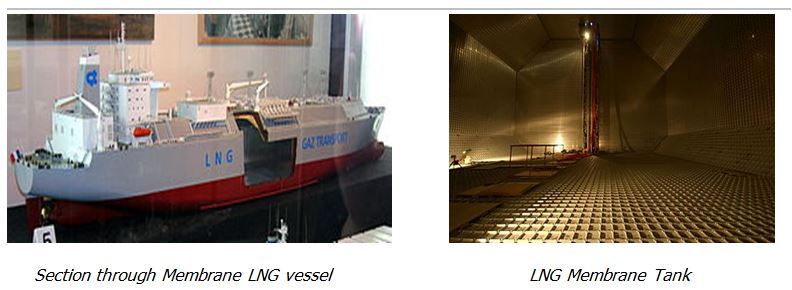
Moss Rosenberg Types – The Moss® LNG tank enables high accuracy of predicted stresses and fatigue life of all parts of the tank structure, eliminating the need for a full secondary barrier. The tanks are generally made from Aluminium and supported around the equatorial ring by a Structural Transition Joint (STJ), which also acts as a thermal break between steel and aluminium. The tanks are then insulated with polyurethane foam which is purged with Nitrogen. A partial barrier in the form of a drip-tray beneath the sphere is fitted. A gas sampling system is fitted to detect any signs of leakage. The complete tank and hold space are protected by weatherproof cover.
Conclusion
LNG shipping sources have recently welcomed the decision by the International Maritime Organization (IMO) marine environment protection committee (MEPC70) to implement a global 0.5 per cent cap on sulphur emissions with effect from 2020, saying it will boost take-up for gas as marine fuel.
Oil & gas exploration and production of LNG is growing worldwide. Keeping a steady pace, world LNG fleet is also growing, which means an increased requirement for skilled and competent seafarers. Training institutes are not yet quite equipped to provide the education needed by the shipping industry for the future. Training seafarers for the existing fleet is not an easy feat, but with the growing number of ships the struggle is likely to grow.
The International Chamber of Shipping (ICS) urged ship owners and managers not to cut training during the shipping downturn. Shipping companies must have an eye to the future and consider that significant growth in shipping could return within the next few years. Employers must recognise that decisions made in difficult times should not inhibit the future sustainability of the industry. Investment in good quality training and recruitment of skilled workforce is an essential part of assuring good industrial health.
Oil and gas industry provides endless opportunities for aspiring mariners. Mariners are engaged in supporting the offshore exploration activities such as: conducting 1D/3D seismic surveys onboard sophisticated seismic survey vessels; drilling well-heads and sub-sea drilling onboard specialized drill ships and semi-submersible rigs; construction of sub-sea asset and manifolds onboard heavy lift offshore construction, dive support and platform supply vessels; rig moving onboard shallow and deep water anchor handling vessels; trenching sub-sea pipe ducts onboard trenching vessels; laying offshore pipelines on pipe-laying vessels and barges; rock dumping on sub-sea pipelines onboard specially designed rock-dumping vessels; towing offshore platforms from long distances onboard ocean going tug and barges; surveying offshore pipelines and sub-sea assets onboard survey vessels and providing ongoing logistical supports to this vast industry.
The article has endeavoured to promote some essential basic knowledge of a growing and sustainable industry for aspiring mariners and future workforce. LNG is continuing to becoming the sustainable and clean fuel for the future not just as a marine fuel, but in all aspects of our daily lives. (Learn more⁴).
List of References:
¹https://www.youtube.com/watch?v=s9oMknya7Rg
²https://www.chevronaustralia.com/our-businesses/gorgon
³https://www.chevronaustralia.com/our-businesses/wheatstone
⁴https://www.youtube.com/watch?v=6UalBcntsZI
http://www.woodside.com.au/Our-Business/Producing/Pages/North-West-Shelf.aspx#.WDGMKM5OJjo
https://www.chiyoda-corp.com/technology/en/lng/liquefaction.html
https://www.chevronaustralia.com/our-businesses/wheatstone
https://www.chevronaustralia.com/our-businesses/gorgon
https://en.wikipedia.org/wiki/Liquefied_natural_gas
http://www.lngworldshipping.com/index.htm
http://www.chevronbangladesh.com/
[Author – Manjur Khan (LinkedIn), a master mariner (Australia) with over 24yrs of experience in Australian maritime industry as Marine Pilot-Loadmaster for LNG projects (Gorgon & Wheatstone), within port regulatory and operations, offshore support vessels operation management, Commonwealth (AMSA) and State (NSW) maritime regulatory administrations and search & rescue, liner shipping cargo operations, at maritime training institutes; as master on tall-ship ‘Bounty’, offshore oil & gas support and ocean going vessels].




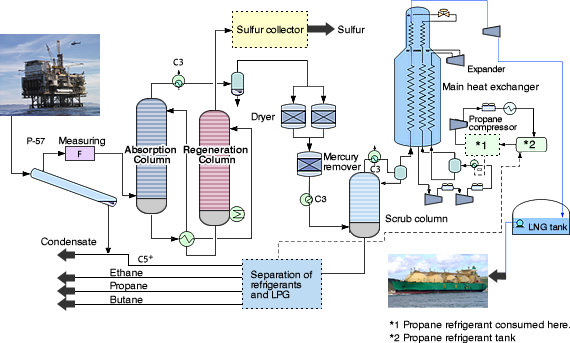
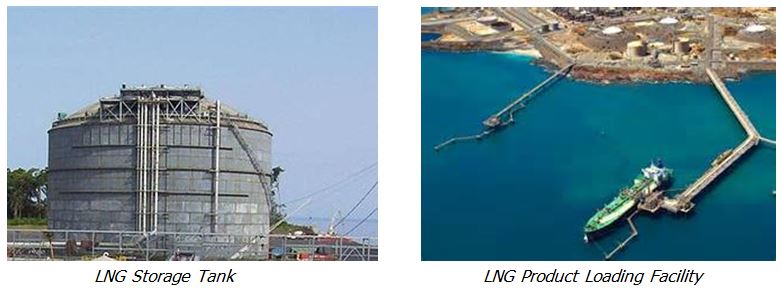




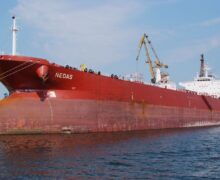


![[নোঙর 2016] আমার সেরা বিদেশ ভ্রমন : নাফিসা মাশহুরা ইরা](http://bdmariners.org/wp-content/uploads/2016/06/Dubai-city-tour-70x70.jpg)




Recent Comments